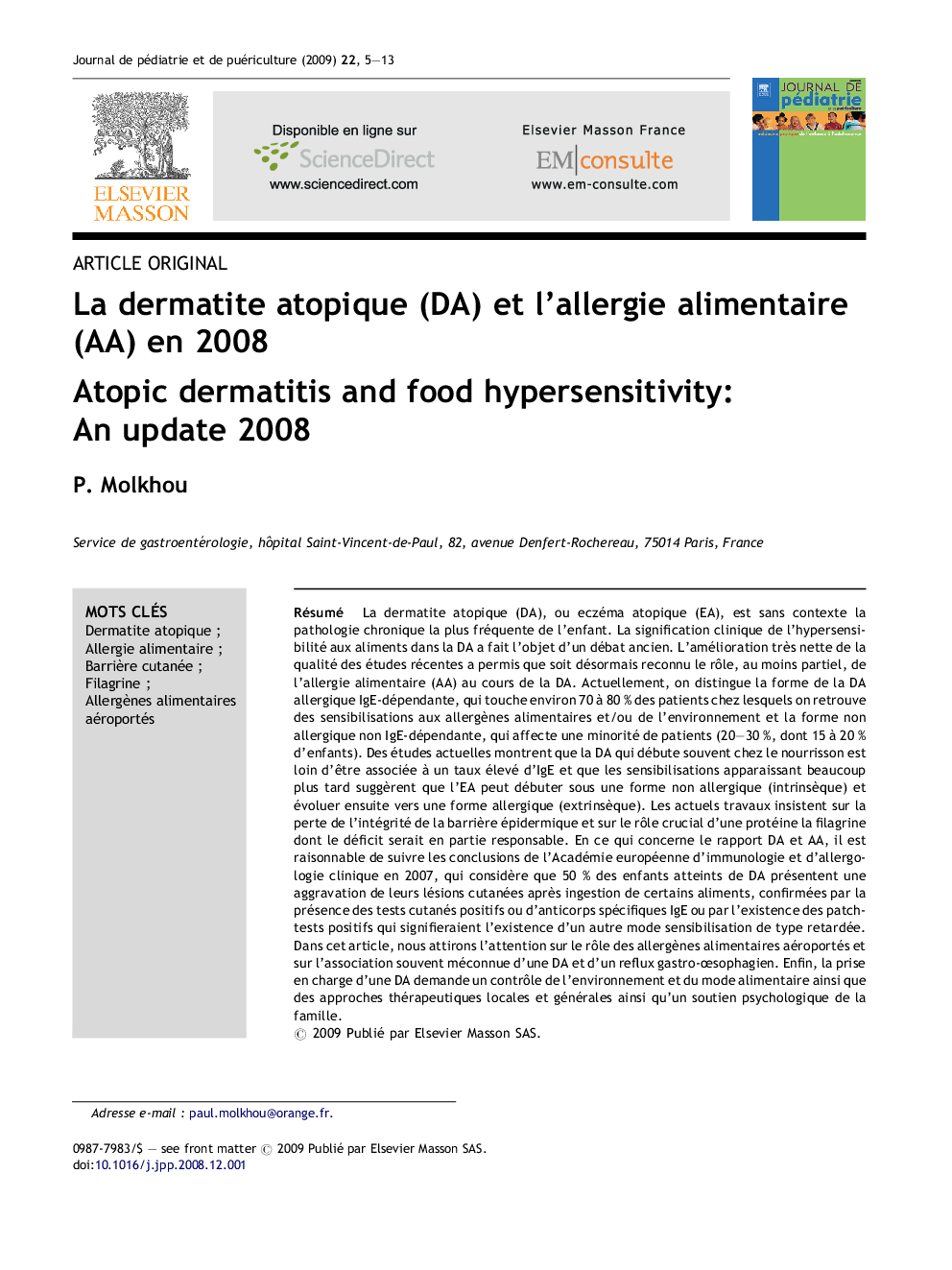| Article ID | Journal | Published Year | Pages | File Type |
|---|---|---|---|---|
| 4170208 | Journal de Pédiatrie et de Puériculture | 2009 | 9 Pages |
RésuméLa dermatite atopique (DA), ou eczéma atopique (EA), est sans contexte la pathologie chronique la plus fréquente de l’enfant. La signification clinique de l’hypersensibilité aux aliments dans la DA a fait l’objet d’un débat ancien. L’amélioration très nette de la qualité des études récentes a permis que soit désormais reconnu le rôle, au moins partiel, de l’allergie alimentaire (AA) au cours de la DA. Actuellement, on distingue la forme de la DA allergique IgE-dépendante, qui touche environ 70 à 80 % des patients chez lesquels on retrouve des sensibilisations aux allergènes alimentaires et/ou de l’environnement et la forme non allergique non IgE-dépendante, qui affecte une minorité de patients (20–30 %, dont 15 à 20 % d’enfants). Des études actuelles montrent que la DA qui débute souvent chez le nourrisson est loin d’être associée à un taux élevé d’IgE et que les sensibilisations apparaissant beaucoup plus tard suggèrent que l’EA peut débuter sous une forme non allergique (intrinsèque) et évoluer ensuite vers une forme allergique (extrinsèque). Les actuels travaux insistent sur la perte de l’intégrité de la barrière épidermique et sur le rôle crucial d’une protéine la filagrine dont le déficit serait en partie responsable. En ce qui concerne le rapport DA et AA, il est raisonnable de suivre les conclusions de l’Académie européenne d’immunologie et d’allergologie clinique en 2007, qui considère que 50 % des enfants atteints de DA présentent une aggravation de leurs lésions cutanées après ingestion de certains aliments, confirmées par la présence des tests cutanés positifs ou d’anticorps spécifiques IgE ou par l’existence des patch-tests positifs qui signifieraient l’existence d’un autre mode sensibilisation de type retardée. Dans cet article, nous attirons l’attention sur le rôle des allergènes alimentaires aéroportés et sur l’association souvent méconnue d’une DA et d’un reflux gastro-œsophagien. Enfin, la prise en charge d’une DA demande un contrôle de l’environnement et du mode alimentaire ainsi que des approches thérapeutiques locales et générales ainsi qu’un soutien psychologique de la famille.
SummaryAtopic dermatitis (AD), or atopic eczema (EA), is a chronic, relapsing, inflammatory skin disease. Children with AD tend to have a higher prevalence of food allergies. AD is an early manifestation of atopy and one of the most common skin disorders seen in infants and children, usually has its onset during the first 6 months of life. Because the role and immunology of food allergy in AD remain controversial, here we review data that mainly focus on skin eczema and food allergy. Recent findings (EAACI 2007) have revealed that more than 50% of all children with AD that can be exacerbated by certain foods will react with a worsening of skin eczema alone or in addition to immediate symptoms. These symptoms include immediate reactions within minutes after ingesting food with early and late exacerbations of AD. There are two main subtypes of AE, i.e. the IgE-associated “EA” and the non-IgE associated type “non-EA” with different prognosis concerning the development of respiratory diseases “atopy march”. AD is not always associated with increased levels of serum IgE and with sensitization to food allergens. Recently, it was demonstrated that Filaggrin (filament-aggregating protein, FL) is a major gene for EA. Filaggrin binds to and aggregates the keratin cytoskeleton in the epidermis. In particular, the identification of loss of function mutations in the barrier protein filaggrin has been recently identified. The importance of skin barrier dysfunction has been highlighted in the pathogenesis of AD, particularly as it relates to allergen sensitization and eczema severity. It is important to identify clinically relevant sensitizations to foods using skin prick tests, a specific IgE blood test (ImmunoCAP®, Phadia), patch-tests and double-blind, placebo-controlled food challenges to initiate appropriate dietary interventions and avoid unnecessary dietary restrictions. Appropriate skin care to maintain skin barrier function and dietary avoidance of highly allergenic foods during infancy may help to prevent allergen sensitization, thereby reducing the severity of AD and food allergies. The results of our studies support the evidence that the risk for development of early allergic manifestations e.g. CMA and AD can be reduced significantly by simple dietary measures for the first 4 months of life. In all infants breastfeeding should be recommended for at least 4–6 months. Food hypersensitivity and food airborne allergens may play a role in the pathogenesis of AD. The aim of this study was to evaluate the kind of food and airborne allergens which may most often induce and intensify AD lesions and also to assess the variability and the kind of allergens leading to AD. Besides other trigger factors, food allergens have been shown to play a role in the exacerbation and maintenance of eczematous lesions in patients with gastroesophageal reflux with AD, particularly in children. The management consists in reducing irritant allergens and culprit foods and in using emollient cream to deal with dryness and local corticosteroids and topic immunomodulatory drugs (tacrolimus and pimecrolimus) which have substantially improved the treatment of AE. Finally, the implementation of proper dietary avoidance can improve symptoms and provide safety from potentially severe anaphylaxis. However, if inappropriate prescribed, elimination diets can have significant negative nutritional and social consequences.
